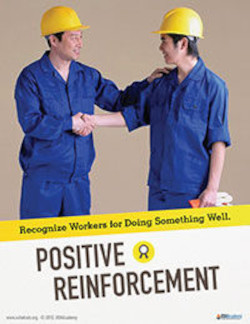Recognition
Every response from a supervisor regarding an employee's safety performance is perceived by the employee as either a positive or negative consequence.
Positive Recognition
To increase the frequency of desired behaviors, supervisors may use forms of recognition that are perceived by employees as positive consequences. Positive recognition not only reinforces compliant behaviors, but it also motivates performance that exceeds basic requirements. When employees are confident, they will be acknowledged and rewarded for their efforts, they are more inclined to excel. Therefore, positive recognition results in higher morale and productivity. Examples of positive recognition include:
- thanking employees for a job well done
- giving employees a bonus
- recommending employees for a promotion
Unfortunately, "desired" performance may not always be safe performance. In companies that prioritize production above safety, supervisors may be very stressed due to having to work long hours at a fast pace to meet challenging deadlines. To assure their own job security, they may only recognize and reward employees for working fast, even at the expense of safety.
Negative Recognition
To increase the frequency of desired performance, supervisors may rely on forms of recognition that employees perceive negatively. Such negative recognition methods can include:
- Yelling at employees for unsafe performance.
- Blaming employees whenever they have an accident.
- Writing negative comments on performance appraisals.
When positive recognition is consistently withheld from employees who achieve or surpass safety performance standards, they may perceive this lack of acknowledgment as a negative consequence. The ongoing absence of positive recognition, regardless of the rationale, can lead to a decline in the frequency of desired behaviors. This decline often stems from a sentiment among employees that if their efforts are unnoticed or undervalued ('if the boss does not care, why should I?').
Ignoring desired behaviors happens every day in some companies, and is probably the most common response to good work experienced by employees. It's very unfortunate because ignoring desired behaviors eventually extinguishes those behaviors.
Remember, in controlling or coercive safety cultures that rely on negative recognition, employees work safely only to stay out of trouble. This approach of negative recognition is fundamentally ineffective, often leading to decreased morale and reduced productivity.
Knowledge Check Choose the best answer for the question.
6-6. Which form of recognition will most likely cause workers to perform beyond mere compliance?
You forgot to answer the question!

